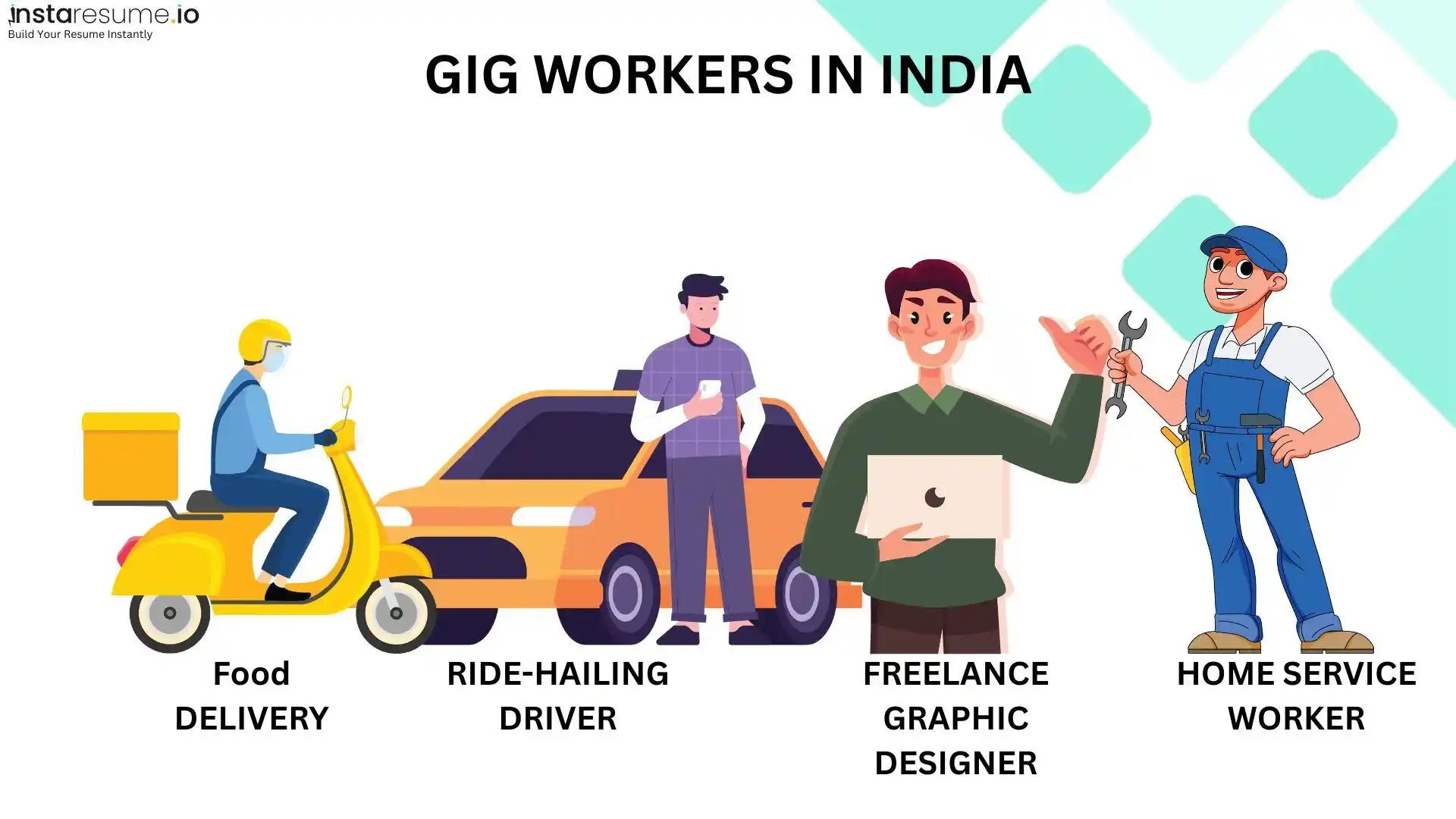What Is a Gig Worker and How to Become One: A Complete Guide
Trust Score: 4.8
355 reviews

The gig economy is booming, transforming the way people work by offering short-term, project-based, and freelance opportunities across industries. From tech and marketing to education and construction, gig work allows professionals to explore flexible career paths without being tied to a traditional 9-to-5 job. Digital platforms now make it easier than ever for freelancers and independent contractors to find projects, showcase their skills, and earn income on their terms.
In this guide, we’ll break down what a gig worker is, the different types of gig work available, the benefits of joining the gig economy, steps to become a gig worker, and practical tips for finding and excelling in gig roles.
Key Takeaways:
 The gig economy offers diverse opportunities for professionals to take on multiple freelance roles across sectors.
The gig economy offers diverse opportunities for professionals to take on multiple freelance roles across sectors. Success as a gig worker requires understanding the gig landscape in your chosen field, building a strong portfolio, and leveraging online platforms and networking.
Success as a gig worker requires understanding the gig landscape in your chosen field, building a strong portfolio, and leveraging online platforms and networking. Continually upgrading skills, using transferable abilities, sharing your portfolio, and seeking referrals can help secure consistent gig work.
Continually upgrading skills, using transferable abilities, sharing your portfolio, and seeking referrals can help secure consistent gig work.
What is a Gig worker?
A gig worker is a professional who takes on short-term, temporary, or project-based work instead of a traditional full-time job. Unlike permanent employees, gig workers are usually paid per task, project, or hour and have the flexibility to work with multiple clients or platforms simultaneously.
Gig work can include a wide range of roles such as freelance writing, graphic design, web development, tutoring, delivery services, consulting, or even specialized technical tasks. The key characteristic is that the work is contractual, flexible, and often platform-based, allowing individuals to balance multiple gigs or explore diverse career paths.
Related Topic: Top work from home jobs with no experience
Examples of Gig Workers:
 A freelance graphic designer creating logos for multiple clients.
A freelance graphic designer creating logos for multiple clients. A delivery driver working with food or package delivery apps.
A delivery driver working with food or package delivery apps. A content writer taking projects from different websites or businesses.
A content writer taking projects from different websites or businesses. An online tutor teaching students from various platforms.
An online tutor teaching students from various platforms.
Pro Tip:
To thrive as a gig worker, it’s important to understand your niche and build a portfolio showcasing your skills. This makes it easier for potential clients to see your expertise and hire you for multiple projects.
Benefits of Being a Gig Worker:
 Flexibility: Choose projects and set your own schedule.
Flexibility: Choose projects and set your own schedule. Variety: Work on different projects across industries.
Variety: Work on different projects across industries. Skill Development: Learn and apply new skills regularly.
Skill Development: Learn and apply new skills regularly. Earning Potential: Opportunity to earn more than a fixed-salary job depending on workload and expertise.
Earning Potential: Opportunity to earn more than a fixed-salary job depending on workload and expertise.
By understanding what a gig worker is and the roles available, you can decide if this flexible work style fits your career goals.
How to become a Gig worker
Pursuing gig work requires planning, preparation, and a strategic approach to consistently find projects.
Here’s a step-by-step guide to help you become a successful gig worker:
1. Understand the Gig Economy
Before diving in, it’s essential to understand the gig economy and the types of jobs available in your chosen sector. Research the qualifications, experience, and skills that companies typically seek in freelancers and independent contractors. Learning to organize your schedule as a gig worker can improve productivity, help you meet deadlines, and maintain a healthy work-life balance.
Setting up the right resources is also crucial. A dedicated workspace, reliable internet, and the necessary tools or software are key to delivering high-quality work. Many successful gig workers approach their careers like running a small business, treating every project professionally, which increases the likelihood of securing ongoing work.
Pro Tip: Establish a regular work schedule to manage multiple gigs efficiently and keep your workflow consistent.
2. Build a Portfolio to Showcase Your Work
A well-curated portfolio is often more valuable than a traditional resume for gig workers. It demonstrates your skills and past work to potential clients, making it easier for them to evaluate your capabilities. Include previous projects, client testimonials, and diverse samples relevant to your niche.
 Example: A web designer should feature completed websites and design projects.
Example: A web designer should feature completed websites and design projects. Example: An independent construction contractor might include project documentation, photos, and client references.
Example: An independent construction contractor might include project documentation, photos, and client references.
Pro Tip: Keep your portfolio updated with your latest and best work to attract more opportunities.
3. Look for Gigs on Online Job Boards
Online platforms and job boards are essential for discovering gigs. Create a professional profile that clearly lists your skills, experience, and qualifications. Platforms often use algorithms to match freelancers with suitable gigs, so a detailed profile increases your chances of being discovered by clients.
Pro Tip: Highlight your niche expertise and showcase your portfolio within your profile to stand out to potential clients.
4. Join Professional Communities and Networks
Networking is crucial for gig workers, who often work independently. Join specialized communities or professional groups online to:
 Discuss potential job opportunities
Discuss potential job opportunities Share or receive referrals
Share or receive referrals Connect with other professionals for support and collaboration
Connect with other professionals for support and collaboration
Being part of a community helps manage the unique challenges of freelance work and can lead to more consistent gigs over time.
Pro Tip: Engage actively in communities by sharing insights or answering questions it builds credibility and trust among peers and potential clients.
Tips for finding Gig work
Finding consistent gig work can be challenging, but with the right strategies, you can secure projects that match your skills and interests. Here are some proven tips to help you get started:
1. Use Multiple Gig Platforms
Don’t rely on just one platform. Explore sites like Upwork, Fiverr, Freelancer, and niche-specific platforms related to your field. Each platform has its own set of clients and projects, increasing your chances of finding suitable gigs.
Using multiple platforms also allows you to compare rates and find projects that fit your schedule and skill level. Some platforms specialize in short-term tasks, while others focus on long-term projects, giving you flexibility in choosing gigs.
Pro Tip: Maintain professional and updated profiles on multiple platforms to maximize visibility. Include clear descriptions, skill tags, and portfolio samples for each platform.
2. Leverage Your Network
Networking remains one of the most effective ways to find gigs. Let friends, colleagues, and industry contacts know you’re available for freelance work. Referrals and recommendations often lead to high-quality projects.
Even casual conversations or social media updates can spark opportunities. Building genuine relationships with professionals in your industry increases trust and makes clients more likely to hire you.
Pro Tip: Attend online webinars, workshops, or local meetups related to your field to expand your professional connections. Follow up with contacts regularly to maintain relationships.
3. Showcase Your Portfolio
A strong portfolio highlights your expertise and previous work. Regularly update it with new projects, client testimonials, and case studies to demonstrate your skills. A well-presented portfolio can be the deciding factor for clients choosing between multiple freelancers.
Include a variety of samples to reflect the full scope of your abilities. Even small projects or personal work can showcase creativity, technical skills, and reliability.
Pro Tip: Tailor your portfolio to the specific type of gig you’re applying for—show relevant work that matches the client’s needs. Consider adding a brief explanation for each sample to highlight the challenges you solved.
4. Apply Strategically
Rather than sending generic applications, customize each proposal to the client’s requirements. Highlight your experience, explain how you can solve their problem, and provide relevant samples.
Clients appreciate freelancers who understand their needs. A thoughtful and personalized application demonstrates professionalism and increases your chances of getting hired.
Pro Tip: Include a short, engaging cover letter or introduction that communicates professionalism and enthusiasm. Keep it concise, highlight your unique value, and address the client by name when possible.
5. Upskill Continuously
The gig economy is competitive, so improving your skills gives you an advantage. Take online courses, earn certifications, or learn complementary skills that increase your versatility.
Upskilling also helps you adapt to changing industry trends and opens doors to higher-paying gigs. Clients are more likely to hire freelancers who stay updated with current tools and practices.
Pro Tip: Track trends in your industry and acquire skills that are in high demand, allowing you to charge higher rates and access better projects. Consider creating micro-projects or practice assignments to demonstrate your new skills.
Related Topic: Interpersonal skills to learn
6. Manage Your Reputation
Positive reviews and repeat clients are key to long-term success. Deliver high-quality work on time, communicate clearly, and maintain professionalism in all interactions.
A strong reputation leads to referrals, long-term projects, and a reliable stream of income. Treat every client interaction as an opportunity to build credibility and trust.
Pro Tip: Request feedback from clients after completing a project to build credibility and attract future opportunities. Display testimonials prominently in your portfolio and professional profiles.
Types of Gig workers
The gig economy is diverse, and gig workers can come from many industries and professions. Understanding the types of gig work available can help you identify opportunities that match your skills and interests. Here’s a breakdown of the most common types of gig workers:
1. Freelancers
Freelancers work independently on a project-by-project basis, offering specialized skills like writing, graphic design, web development, or digital marketing. They often manage multiple clients at once and have the freedom to set their rates and schedules.
Example: A freelance content writer may write blog posts for several businesses in a month.
2. On-Demand Service Workers
These workers provide services that are requested “on-demand” through apps or platforms. This includes delivery drivers, rideshare drivers, personal assistants, or home service providers. They typically have flexible schedules and can choose when and how often to work.
Example: A rideshare driver works on a platform like Uber or Lyft, picking rides whenever convenient.
3. Consultants and Professionals
Some gig workers offer expert advice or professional services on a contract basis. This can include business consultants, marketing strategists, financial advisors, or IT specialists. These roles often require prior industry experience or certifications.
Example: An IT consultant helps small businesses set up their networks and cybersecurity systems for a fixed-term contract.
4. Creative and Artistic Workers
Artists, musicians, photographers, videographers, and designers often take on gigs for specific projects, events, or clients. Their work can be highly specialized and project-focused, often relying on portfolio and reputation to attract clients.
Example: A photographer works at weddings or corporate events on a contract basis.
Related Topic: Graphic designers resume
5. Remote and Online Gig Workers
With digital transformation, many gig roles are fully online. These include virtual assistants, online tutors, transcriptionists, social media managers, and e-commerce freelancers. They can work from anywhere and often collaborate with global clients.
Example: An online tutor teaches English to students overseas via video calls.
Explore: Top work from home jobs
6. Task-Based or Micro-Job Workers
These gig workers take on small, task-based jobs that may only take a few minutes or hours to complete. Examples include survey takers, data entry workers, or app testers. While individual pay may be smaller, consistent tasks can add up.
Example: A micro-task worker tests mobile apps for functionality and reports bugs for a platform like UserTesting.
7. Event Staff and Hospitality Workers
Some gig workers take on temporary roles in events, catering, or hospitality. These jobs are project-based and often tied to specific events or peak seasons.
Example: A banquet server hired for weddings or corporate events.
8. Health and Wellness Professionals
Healthcare practitioners or fitness experts sometimes take gigs for short-term or flexible roles, such as wellness coaching, physiotherapy sessions, or personal training.
Example: A yoga instructor providing online classes on a freelance basis.
Explore: Nurse resume examples
9. Delivery and Logistics Specialists
Beyond typical rideshare drivers, some gig workers specialize in logistics, courier services, or same-day delivery for e-commerce businesses.
Example: A courier delivering packages for multiple e-commerce platforms.
10. Education and Tutoring Professionals
Educators and subject-matter experts often take gigs for tutoring, mentoring, or creating educational content. These roles can be part-time, remote, or flexible based on student demand.
Example: A math tutor conducting weekend online classes for high school students.
Pro Tip: Many gig workers combine multiple types of gigs to maximize income and diversify their experience. For instance, a freelancer may also take on task-based jobs or online gigs to fill gaps between major projects.
Read: Teachers resume examples
Key benefits of a Gig economy
The gig economy is reshaping the way people work, offering flexibility, diverse opportunities, and unique advantages for professionals across industries. Here are the key benefits of participating in the gig economy:
1. Flexibility and Work-Life Balance
One of the biggest advantages of gig work is the ability to set your own schedule. Gig workers can choose when, where, and how much to work, allowing them to balance professional and personal commitments effectively.
Example: A freelance writer can plan work around family responsibilities or pursue personal projects simultaneously.
2. Diverse Opportunities Across Industries
The gig economy opens doors to a wide range of industries, from technology and marketing to education, healthcare, and creative arts. This diversity allows professionals to explore different career paths and gain experience in multiple sectors.
Pro Tip: Use gig work to experiment with different industries or roles, which can help you discover your true strengths and interests.
3. Skill Development and Learning
Gig work encourages continuous learning and skill improvement. Every project presents new challenges, helping professionals build technical, creative, and problem-solving skills. Over time, gig workers become more versatile and marketable.
Example: A graphic designer working with multiple clients learns to adapt to different brand styles and software tools.
4. Higher Earning Potential
Gig work can offer competitive income opportunities. Skilled professionals often earn more than traditional salaries by taking on multiple projects or higher-paying gigs, depending on demand and expertise.
Pro Tip: Track industry trends to identify high-demand skills and projects that offer premium rates.
5. Autonomy and Entrepreneurial Growth
Gig workers operate like small business owners, managing clients, projects, and finances. This independence fosters entrepreneurial skills such as self-promotion, negotiation, and time management.
Example: A freelance consultant managing multiple clients learns how to pitch services, set rates, and handle contracts efficiently.
6. Global Opportunities
The rise of digital platforms allows gig workers to collaborate with clients worldwide. Professionals can access international projects without relocating, expanding their exposure and market reach.
Pro Tip: Build a strong online presence and portfolio to attract clients from different countries and industries.
7. Opportunity to Pursue Passion Projects
Many gig workers choose projects that align with their personal interests or passions, giving them creative freedom and job satisfaction. Unlike traditional roles, gig work allows you to shape your career around what you enjoy most.
Example: A musician offering online music lessons or creating content for independent projects.
By embracing the gig economy, professionals gain flexibility, diverse work experiences, and opportunities for growth while maintaining autonomy over their careers.
Frequently asked questions
Here are some commonly asked questions about gig workers and the gig economy:
1. What are the biggest challenges for the gig workforce?
The primary challenge is the lack of a traditional safety net. Gig workers typically do not receive benefits like health insurance, paid time off, or retirement contributions that full-time employees enjoy. Income can also be unpredictable, and access to social security or unemployment benefits is often limited, which may create financial instability.
Pro Tip: Gig workers can mitigate risks by setting aside savings, investing in private insurance, and diversifying their client base to maintain a steady income.
2. What is the future of the gig economy in India?
The gig economy in India is expanding rapidly and gaining attention from policymakers. Government bodies such as NITI Aayog have published reports on the gig workforce, and legislation like the Code on Social Security aims to provide platform workers with access to benefits for the first time. The future likely involves more formalization, better protections, and structured support for gig workers.
3. Do gig workers need a formal contract?
Yes. While many gigs are short-term, having a formal contract or agreement protects both the worker and the client. Contracts clearly outline deliverables, deadlines, payment terms, and dispute resolution, reducing misunderstandings and legal issues.
4. How do gig workers manage taxes?
Gig workers are considered self-employed in most countries. This means they are responsible for reporting income and paying taxes. Using accounting software or consulting a tax professional can help track earnings and deductions efficiently.
5. Can gig work lead to a full-time career?
Absolutely. Many gig workers transition into long-term careers by building consistent client relationships, a strong portfolio, and specialized expertise. Some even start agencies or businesses based on their freelance work.
6. What skills are most in demand for gig work?
High-demand skills vary by industry, but some consistently sought-after skills include:
 Digital marketing and SEO
Digital marketing and SEO Web and app development
Web and app development Graphic design and multimedia
Graphic design and multimedia Writing and content creation
Writing and content creation Data analysis and consulting
Data analysis and consulting Online teaching and tutoring
Online teaching and tutoring
Pro Tip: Continuously updating your skills and learning new tools increases your chances of securing high-paying gigs.
7. What is the difference between platform workers and gig workers?
Platform workers perform tasks through digital platforms (like Uber, Swiggy, or Upwork), while gig workers include anyone doing temporary, project-based, or freelance work. All platform workers are gig workers, but not all gig workers rely on platforms—they may secure projects directly from clients or through personal networks.






